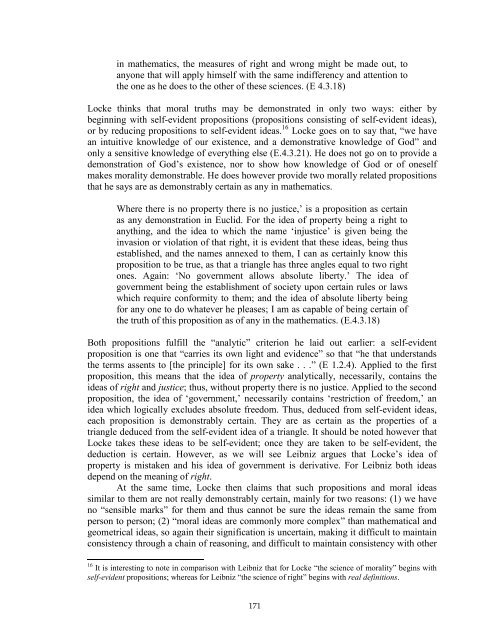Stony Brook University
Stony Brook University
Stony Brook University
Create successful ePaper yourself
Turn your PDF publications into a flip-book with our unique Google optimized e-Paper software.
in mathematics, the measures of right and wrong might be made out, to<br />
anyone that will apply himself with the same indifferency and attention to<br />
the one as he does to the other of these sciences. (E 4.3.18)<br />
Locke thinks that moral truths may be demonstrated in only two ways: either by<br />
beginning with self-evident propositions (propositions consisting of self-evident ideas),<br />
or by reducing propositions to self-evident ideas. 16 Locke goes on to say that, “we have<br />
an intuitive knowledge of our existence, and a demonstrative knowledge of God” and<br />
only a sensitive knowledge of everything else (E.4.3.21). He does not go on to provide a<br />
demonstration of God’s existence, nor to show how knowledge of God or of oneself<br />
makes morality demonstrable. He does however provide two morally related propositions<br />
that he says are as demonstrably certain as any in mathematics.<br />
Where there is no property there is no justice,’ is a proposition as certain<br />
as any demonstration in Euclid. For the idea of property being a right to<br />
anything, and the idea to which the name ‘injustice’ is given being the<br />
invasion or violation of that right, it is evident that these ideas, being thus<br />
established, and the names annexed to them, I can as certainly know this<br />
proposition to be true, as that a triangle has three angles equal to two right<br />
ones. Again: ‘No government allows absolute liberty.’ The idea of<br />
government being the establishment of society upon certain rules or laws<br />
which require conformity to them; and the idea of absolute liberty being<br />
for any one to do whatever he pleases; I am as capable of being certain of<br />
the truth of this proposition as of any in the mathematics. (E.4.3.18)<br />
Both propositions fulfill the “analytic” criterion he laid out earlier: a self-evident<br />
proposition is one that “carries its own light and evidence” so that “he that understands<br />
the terms assents to [the principle] for its own sake . . .” (E 1.2.4). Applied to the first<br />
proposition, this means that the idea of property analytically, necessarily, contains the<br />
ideas of right and justice; thus, without property there is no justice. Applied to the second<br />
proposition, the idea of ‘government,’ necessarily contains ‘restriction of freedom,’ an<br />
idea which logically excludes absolute freedom. Thus, deduced from self-evident ideas,<br />
each proposition is demonstrably certain. They are as certain as the properties of a<br />
triangle deduced from the self-evident idea of a triangle. It should be noted however that<br />
Locke takes these ideas to be self-evident; once they are taken to be self-evident, the<br />
deduction is certain. However, as we will see Leibniz argues that Locke’s idea of<br />
property is mistaken and his idea of government is derivative. For Leibniz both ideas<br />
depend on the meaning of right.<br />
At the same time, Locke then claims that such propositions and moral ideas<br />
similar to them are not really demonstrably certain, mainly for two reasons: (1) we have<br />
no “sensible marks” for them and thus cannot be sure the ideas remain the same from<br />
person to person; (2) “moral ideas are commonly more complex” than mathematical and<br />
geometrical ideas, so again their signification is uncertain, making it difficult to maintain<br />
consistency through a chain of reasoning, and difficult to maintain consistency with other<br />
16 It is interesting to note in comparison with Leibniz that for Locke “the science of morality” begins with<br />
self-evident propositions; whereas for Leibniz “the science of right” begins with real definitions.<br />
171
















